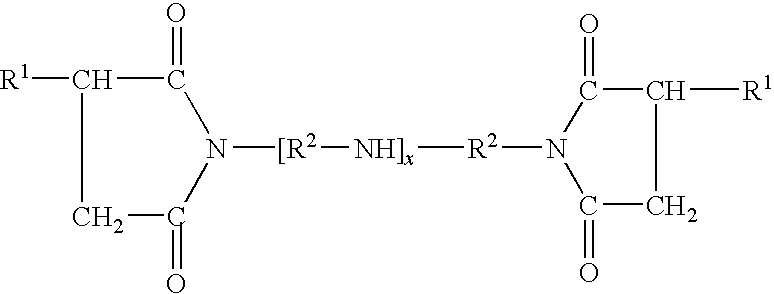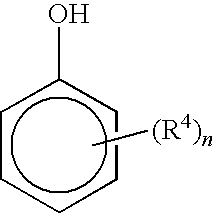Nitrogen-containing dispersant as an ashless TBN booster for lubricants
a technology of tbn booster and nitrogen-containing dispersant, which is applied in the direction of lubricant composition, liquid carbonaceous fuel, additives, etc., can solve the problems of serious impact of engine oil level, adding ash or harming, and achieve the effect of improving the seal compatibility of engine oil composition
- Summary
- Abstract
- Description
- Claims
- Application Information
AI Technical Summary
Benefits of technology
Problems solved by technology
Method used
Image
Examples
example 1
Reference
[0077]A baseline lubricant formulation is prepared of the following components:
50.1% 260 N mineral oil
21.5% 130 N mineral oil
15% styrene / isoprene polymer viscosity index modifier, incl. 94% diluent oil
0.2% pour point depressant, including 54% diluent oil
7.2% succinimide dispersant, incl. 50% dil. oil, 27 TBN, N:CO ratio 1.3-1.6:1.
1.5% overbased calcium sulfonate detergents, including ˜44% diluent oil
1.08% overbased calcium alkylphenol sulfide detergents, incl. ˜35% dil. oil
0.15% alkyl aromatic amine antioxidant
0.16% sulfurized olefin antioxidant
1.2% hindered phenolic ester antioxidant
0.02% thiadiazole corrosion inhibitor
0.98% zinc dialkyldithiophosphate, including 9% diluent oil
0.01% siloxane antifoam agent, including 90% diluent oil
1.01% additional diluent oil
examples 2-10
[0078]To the above baseline lubricant formulation is added an amount, as indicated in the following table, of a high TBN nitrogen containing dispersant. This dispersant is, in particular, a succinimide material prepared by condensation of about 6.5 parts by weight of a polyisobutene-substituted succinic anhydride (Mn about 1000) with 1 part by weight of commercial tetraethylenepentamines (TEPA). This dispersant has a TBN of about 100 in a concentrate containing 14% oil, or about 116 on an oil free basis, as reported in the table below (The “High TBN dispersant”). This is in addition to the conventional dispersant which is already present in the baseline formulation.
reference examples 11-13
[0079]For comparison purposes, a series of formulations are also prepared by adding to the same baseline formulation (which contains the 7.2% succinimide dispersant), the additional amounts indicated of a conventional succinimide dispersant, prepared from about 13.2 parts by weight of a polyisobutene (Mn about 2000)-substituted succinic anhydride and 1 part by weight of a mixture of polyethylene polyamines. The reference dispersant has a TBN of about 27 in a concentrate containing 50% oil, or about 54 on an oil free basis, as reported below.
[0080]The experimental samples are tested for their effect on Viton™ fluorocarbon specimens by the MB (Mercedes Benz™) test and the MTU (MTU Friedrichshafen) test. The MB test involves immersing a fluorocarbon elastomer in a beaker containing 350 mL of the sample to be evaluated and heating it to 150° C. for 168 hours. The change in tensile strength of the sample after treatment is measured. The MTU test is similar but uses a different specific f...
PUM
| Property | Measurement | Unit |
|---|---|---|
| viscosity index | aaaaa | aaaaa |
| weight percent | aaaaa | aaaaa |
| weight percent | aaaaa | aaaaa |
Abstract
Description
Claims
Application Information
 Login to View More
Login to View More - R&D
- Intellectual Property
- Life Sciences
- Materials
- Tech Scout
- Unparalleled Data Quality
- Higher Quality Content
- 60% Fewer Hallucinations
Browse by: Latest US Patents, China's latest patents, Technical Efficacy Thesaurus, Application Domain, Technology Topic, Popular Technical Reports.
© 2025 PatSnap. All rights reserved.Legal|Privacy policy|Modern Slavery Act Transparency Statement|Sitemap|About US| Contact US: help@patsnap.com



